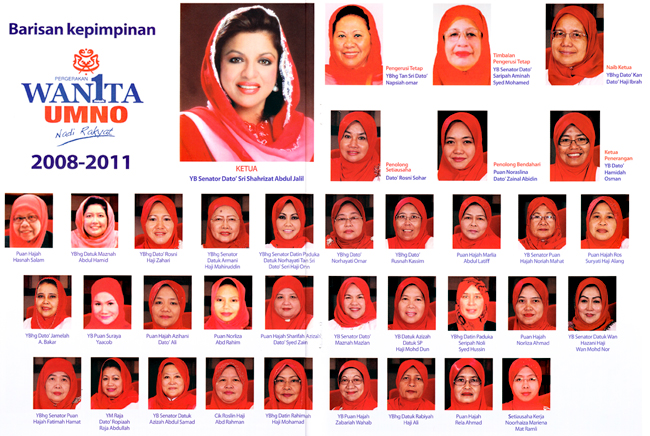Based on the final results, approximately 24 women have been elected to the 13th Malaysian Parliament. That means that from the 12th Malaysian Parliament, there has been a net gain of: one.
The results demonstrate the continuance of a pattern I have previously written about: progress on women’s representation at a federal level will continue to move very slowly unless urgent action is taken.
For a political system that saw both sides of the political divide publicly embrace the concept of gender equality and increased women’s leadership, the results here are frustrating to say the least.
The women’s wings in Barisan Nasional (BN) component party United Malays National Organisation (UMNO) was the initial wing to ask for increased women’s representation in federal parliament, but have continued to be sidelined over the years. Wanita UMNO has nonetheless continued to campaign “loyally” for the party, and the figures from this election continue to point to the muddled relationship between UMNO and its women’s wing: eight of the 24 women elected were from UMNO, which makes UMNO the party that has produced the most women representatives.
The other seven women elected for BN were elected in Sarawak and Sabah, and were from local component parties there.
Five of the nine women elected for PR were from its component party Parti Keadilan Rakyat (PKR). Two were from Parti SeIslam Malaysia (PAS), including Siti Mariam Mahmud in Kota Raja. It is believed that, despite coming from PAS, Siti Mariam won her seat in 2008 due to support from Chinese and Indian voters. The other two women elected for PR were from the Democratic Action Party (DAP).
The biggest factor in helping the women parliamentarians get elected was incumbency: 16 of the elected women candidates had also won their seats in 2008. Six of the women elected won in seats where the ticket they were running on had won in 2008.
Only two women candidates succeeded in defeating incumbents or candidates whose party had previously won the seat: Teo Nie Ching in her famously bold move to Kulai, and Alice Lau Kiong Yieng in Lanang. To put this in perspective, 37 seats changed hands between the two coalitions in this election, and two of hese 37 were won by women.
There are two federal territories and five states that will have no women representatives in the new Parliament.
The two federal territories of Putrajaya and Labuan, each with only one seat, saw no women candidates stand for election. The only state where no women candidates stood was Perlis.
In Kedah, Marina Hussein stood as independent in Langkawi, and Nor Azrina Surip ran for PR in Merbok. It was always going to be an uphill battle for Marina as an independent, but Nor Azrina was running in a seat that PR had won with a 3,000-vote margin in 2008. Their defeats mean Kedah have no women federal representatives.
In Terengganu, only one woman was running, and as an independent too. Maimun Yusof ultimately lost in the Kuala Terengganu race to newcomer Raja Bahrin Shah for PR, in a seat that was previously won by PR in 2008.
The other two states where no women were elected are Perak and Negeri Sembilan. There, the women candidates standing lost to either incumbents or candidates whose coalition had previously won the seat in 2008.
Of the 222 seats being contested in this election, only six had two or more women candidates standing. In these six seats (Ampang, Seputeh, Penggerang, Ranau, Tawau and Tanjong Manis), a woman was elected.
Women ran in some 47 seats, and won around half of those. Where they did lose it was, in all but two cases, to incumbents or in seats that the victorious party had previously won in 2008. In both Penampang and Stampin where this did occur, the two women running were doing so for minor parties and faced an uphill battle to begin with.
There are a few reasons why women candidates have a hard time getting elected. One is that political parties have not made increasing women’s representation a priority – political will is necessary in achieving last change.
Secondly, the first-past-the-post electoral system is not as helpful in getting women elected as the proportional representative electoral system. Implementing quotas should also be considered to help boost women’s numbers.
Finally, the political environment needs to adopt more gender-sensitive outlooks and policies to help encourage women to take up politics.
Without these changes, the number of women in the federal parliament will not change significantly in the 14th Malaysian parliament and beyond.
Correction: 07/05/2013
It has been brought to our attention that four of the nine women elected are from the DAP, instead of two noted in the article. The four are Kasthuri Patto (Batu Kawan; the only Indian woman in Malaysia’s 13th Parliament) , Alice Lau (Lanang), Teo Nie Ching (Kulai) and Teresa Kok (Seputeh).
 Facebook
Facebook  Twitter
Twitter  Soundcloud
Soundcloud  Youtube
Youtube  Rss
Rss 